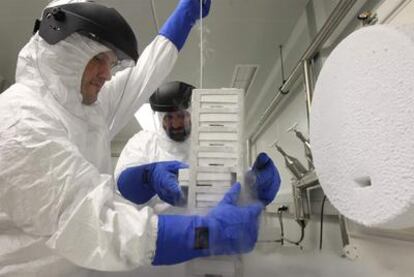Stem cell research to speed delivery of new medicines
The use of stem cells in testing chemical compounds could bring about significant improvements to the process of drug development
While media headlines have largely focussed on the seemingly miraculous cures that transplanting stem cell therapies directly to patients may one day offer, in reality one of the most far-reaching benefits of stem cell research is likely to be the accelerated development of new drugs.
My own work at the Medical Research Council Centre for Regenerative Medicine at the University of Edinburgh focuses on just this, looking at ways that we can develop and grow liver cells with a view to testing drugs and reducing waste in pharmaceutical development. At present, the cost of human drug development is heavily influenced by various compounds that in the end are discounted. For every drug that reaches the market, some 5,000 to 10,000 have been tested before clinical trials even begin. Each new drug takes many years to develop and pre-approval costs are generally in the region of more than $1 billion per approved drug. Often the drugs have to be withdrawn at this stage because of the unwanted side effects. The use of stem cells in testing chemical compounds could bring about significant improvements to the process of drug development.
It is only a few years since scientists first turned back the clock on human skin cells, reprogramming them to become stem cells with the ability to turn into different cells within the body. In the short space of time since this breakthrough, researchers across the world have been working to refine the process of creating these cells, which are known as induced pluripotent stem cells. These cells will not only help us better understand disease but will also, we hope, enable us to develop new and better treatments for a range of illnesses and diseases.
The ability to form induced pluripotent stem cells means that one day we could create bespoke cells or tissues, which we could transplant to patients without the fear of rejection. Yet, there are still hurdles to overcome. This includes ensuring that manipulating genes to create these cells does not, in turn, bring about harmful mutations.
A Library of Liver Cells
One of the reasons that testing new drugs is not as efficient as it could be is that the liver cells used in testing come from dead or donor tissue, which is often diseased. As a result the cells are generally of poor quality; they do not survive for long and do not multiply, making them less reliable for drug testing. While animal models are highly valuable in predicting the toxic nature of candidate drugs for human use, they also have limitations and possess specific variations in their response to drugs. Even the human population does not process drugs in a generalised fashion, and different ethnic groups may be more prone to certain adverse reactions because of the way their livers metabolise the drugs.
The transfer of knowledge from human embryonic stem cells to induced pluripotent stem cells has already paved the way for the creation of a library of liver cells for different populations. We have been able to create liver cell lines from adult skin cells taken from caucasians and native americans; thus, we can now produce specific liver cells to account for different ethnicities, using the cells to identify potential adverse reactions among different groups of the population.
A resource of unlimited, ethical and genetically diverse liver cells, formed from induced pluripotent stem cells, has the ability to revolutionise how we define drug metabolism and test medicines. Such a resource would also help us identify key factors in how cells differentiate to become liver cells. Ultimately though, by modelling liver disease in a petri dish we hope to bring about improved treatments.
Currently, the only treatment for end stage liver disease is a liver transplant, and there are more people who need transplants than there are livers available. Stem cells could prove crucial in helping us find a way in which we can enable the liver to function, either helping it to regenerate or providing more time until an organ becomes available for transplantation. One idea is to create a bio-artificial liver, which would be used in a similar manner to a kidney dialysis machine, used to clear toxins from the blood. This could be achieved by "fuelling" the bio-artificial liver device with stem cell-derived liver cells that work in the same way as healthy liver cells and process the patient's blood, providing critical liver support.
In the space of just a few years stem cell research has evolved considerably, and it continues to do so as key discoveries are made. There is still much research that needs to be carried out, but progress is more than promising.
David C. Hay, University of Edinburgh. www.atomiumculture.eu

Tu suscripción se está usando en otro dispositivo
¿Quieres añadir otro usuario a tu suscripción?
Si continúas leyendo en este dispositivo, no se podrá leer en el otro.
FlechaTu suscripción se está usando en otro dispositivo y solo puedes acceder a EL PAÍS desde un dispositivo a la vez.
Si quieres compartir tu cuenta, cambia tu suscripción a la modalidad Premium, así podrás añadir otro usuario. Cada uno accederá con su propia cuenta de email, lo que os permitirá personalizar vuestra experiencia en EL PAÍS.
¿Tienes una suscripción de empresa? Accede aquí para contratar más cuentas.
En el caso de no saber quién está usando tu cuenta, te recomendamos cambiar tu contraseña aquí.
Si decides continuar compartiendo tu cuenta, este mensaje se mostrará en tu dispositivo y en el de la otra persona que está usando tu cuenta de forma indefinida, afectando a tu experiencia de lectura. Puedes consultar aquí los términos y condiciones de la suscripción digital.
Archivado En
Últimas noticias
Lo más visto
- Víctor Bermúdez, profesor de Filosofía: “Hemos perdido el control del proceso educativo, lo que damos en clase es en gran medida un simulacro”
- “Un jardín con casa, no una casa con jardín”: así es la premiada vivienda de 146 metros cuadrados que se camufla con la vegetación
- Zelenski confirma que cualquier pacto con Rusia deberá ser ratificado en referéndum
- La revalorización de las pensiones queda en el aire por la negativa de la derecha a apoyar otras medidas sociales
- TVE se reivindica (con pulla) en su gran noche televisiva




























































